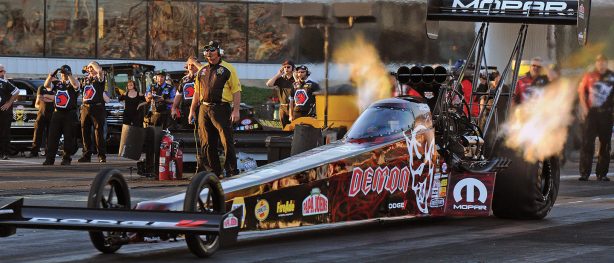Part of the attraction of watching flame-throwing Top Fuel dragsters pound down the track at NHRA events is the anticipation of the astonishing speed numbers they can generate. Sitting in the stands, feeling your chest pound, taking in the indescribable crackling thunder of 10,000 horsepower bursting from the exhaust headers is all paid off when the magic speed number pops up on the scoreboard at the end of the track.
Sure, the 500-cubic-inch HEMI engines make the power, but that’s only part of the battle. Applying all that power to the track is the key to record-setting runs. And a big part of applying the horsepower to the track is accomplished with those large wings on the front and rear of every Top Fuel dragster.
“The rear wing is the thing that makes our cars as quick as they are,” says Mike Green, veteran Top Fuel Crew Chief. “The rear wing is oversized for the vehicle and the amount of rear downforce we can make is pretty high.”
Downforce is the early part of the run and helps traction. “At 300 mph, the rear wing makes somewhere in the neighborhood of 5,000 to 6,000 lbs. of downforce,” says Green. “We’re getting close to 300 mph at the 1/8-mile mark of the run, so it adds a lot of downforce; we can accelerate the car harder and harder.
“After that (the 1/8-mile), the wing produces a lot of drag so there is definitely an aero balance we need to how much wing to run (angle and size) in the first part of the track and not have too much drag in the back half.”
That is where crew chiefs earn their daily wages.
“We tune the car around the rear wing and tune the rear wing around the race tracks for how quick we can run,” says Green. “We then aero balance the car by changing the angle of attack on the front wing.”
The front wing, in the early parts of the run, is essential in keeping the front wheels planted on the track, overcoming the inherent lift generated by accelerating forces of the giant rear slicks.
MUDFLAPS
Another key aero element on a Top Fuel car is the side panels – or mudflaps – that rest just ahead of the rear sticks, forward of the engine.
“Years ago, when I was working with Don Prudhomme,” says Green, “we put those flaps on the side and they made a big difference. There was a lot of air that went under the car and between the rear tires. When we put those on, at first, they took abut 1,200 lbs. of lift away from the car, so that was a big aero improvement as far as traction goes.” Everyone runs those “‘mudflaps” to this day.
With safety in mind, many teams tried various forms of driver compartment canopies. The canopy also had a chance to improve aero.
“We did aero work with NHRA on the canopy,” says Green. “They wouldn’t allow us to run a canopy until we did some work with them and compared it to an open cockpit car. We did a lot to prove it wasn’t a big aero advantage. The canopy offered a little bit of an advantage, we knew it would, so you can see a 3/4-inch lip on the back of the canopy to eliminate the advantage. We built it for safety, not for aero.”
There have not been many changes to Top Fuel wing technology in the past 10 years, and it’s likely there won’t be major changes coming soon. Achieving 330 mph in only 1,000 feet is astonishing enough for now. And those big wings and HEMI engine horsepower help make it all possible.
